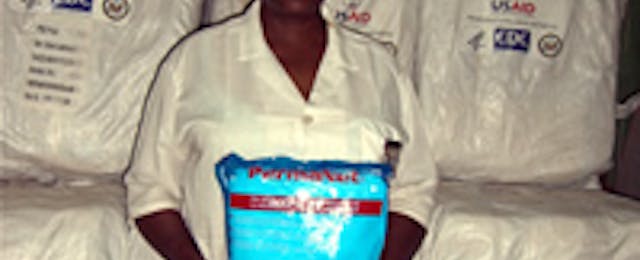
The long-lasting insecticide-treated net (LLIN) is one of the main weapons in Africa’s arsenal against malaria. Based on the continent’s distribution of the disease, the estimated annual need of sub-saharan Africa’s 700 million population is 60-80 million nets. When properly used in sleeping areas, LLIN’s could decrease childhood cases and deaths from malaria by at least 50 percent.
Some have “run the numbers” on how to save lives with bed nets–it goes something like this. Multiply the nets needed by the cost of nets delivered. Multiply this by five to cover the five-year effective useful life of a net. Bottom line: for $3-4 billion, Africa could be blanketed by the requisite nets.
The Mali integrated child health campaign has allowed our observation team to “get our hands dirty” in looking at the details of how nets are moved from production site to the end of the road. In previous similar campaigns in Nigeria and Angola, ExxonMobil sponsored the United Nations Foundation and the World Health Organziation “logistcians” to provide supply chain management support, and to study how to make delivery of nets more efficient on a broad country scale.
Now here in Bamako, I sit down with Steve Lutterback of PSI, a global health NGO, and Doug Mole of the Canadian Red Cross. They have provided full-time logistical support to the campaign for LLIN distribution for the past seven months. Over drinks at the Lybia hotel, I ask them to map the supply chain of nets for this campaign (we have only 10 minutes for this diversion because they have to get back to REAL work.)
Here is the story of how the 2.26 million nets will each make their way into the hands of a pregnant Malian mother and all mothers with children under age five (the nets were funded by a consortium including the U.S. President’s Malaria Initiative, the Canadian Red Cross, Malaria No More, and the UN Foundation’s Nothing But Nets campaign.)
Orders were placed with a manufacturer who sourced the nets from Vietnam, seven months pre-campaign. The nets were contained and shipped in 58 “high cube containers” (40 x 91/2 x 8 feet), from Vietnam to a sorting transit point in Spain. Each container holds about 38,000 nets.
The cargo was sorted and re-loaded to a second ship for its journey through the straits of Gibraltar and down the West African Coast. To Dakar, Senegal. It took 55 days for the shipment to arrive in port of Dakar.
Over the next two-three weeks the cargo was transported over 1200 kilometers of road and rail to Bamako, Mali. It required a futher seven days to clear customs.
The 58 containers were transferred to the only three warehouses in the country sufficiently large to store them. They filled the three 1100m2 warehouses.
The distribution plan called for 40 health districts to receive shipments in six regions of the country over a radius of 600 km from Bamako. A single transport company won the tender and used 60 runs by 40 trucks to deliver bales of uncrated nets. Transport was about 50 percent on “tire roads’ which are paved, and 50 percent on unpaved dirt roads. It required ten days to accomplish this phase. Many of the roads would have been unpassable in the rainy season. The paradox was striking — the nets could only be delivered reliably during the dry season, when malaria risk is the lowest.
From the 40 district locations nets were subdivided for shipment to 975 health centers. It took 1-10 days to accomplish this. While awaiting trans-shipment, the bales of nets were often subject to “outdoor warehousing” with a hired security guard sitting on top of the bales to prevent theft.
From the health centers, the nets were sent to 2000-3000 distribution points with a radius of 5-20 km. This was accomplished via a variety of transportation modes including bicycle, donkey-cart, camel and “push-push”, a local cartlike conveyence pushed by human power.
For mothers who could not make it to the final distribution points, mobile teams on bicycles and motorcycles would deliver the nets to their villages and dwellings. In the end, all of Mali’s 15,000 villagers are covered.
Elapsed time seven months. Number of people coordinating logistics–6. Los or damage of nets–none.
Listening to Doug and Steve’s animated description of their activities left me with awe and wonder. Their enthusiasm, single-minded commitment, and utter conviction that there was no barrier that they could not overcome was clearly evident. This was the sournce of my awe.
The source of my wonder was the disconnect between the bold overtures of some global campaigners and the gritty reality on-the-ground. Some think malaria requires a good calculator and money. Figure out the aggregate need, fund it, and procure the requisite commodities. This both discounts and the complexity of the delivery of goods to the end beneficiary and undervalues the overwhelming diligence, creativity and dedication of the on-the-ground implementors.
This describes the bed net logistics story to remind us the integrated Mali child health campaign supplies a package that includes four other interventions: vitamin A, polio and measles vaccinations, and de-worming medication. They all have logistics too…
Tomorrow: meeting the Mali president and the meaning of “political will.”